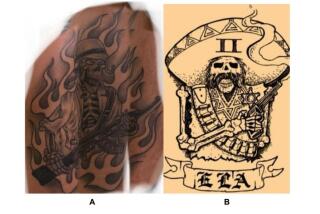Army’s Opposition to Ink Fading
- Share via
WASHINGTON — The Army has a message for the growing legions of flamboyantly tattooed American teens: Uncle Sam even wants you.
Facing one of the worst recruiting climates in the allvolunteer military’s history, the Army has decided to relax standards that dictate which parts of a soldier can be festooned with body art. Specifically, the service will accept recruits with tattoos on their neck and hands.
The service long had prohibited soldiers from having tattoos on places not covered by a dress uniform.
But after missing Army recruiting goals last year, commanders are looking for every way possible to expand the pool of candidates.
Over the last year, the Army has begun accepting more recruits who score poorly on mental aptitude tests and who don’t have high school diplomas. It has begun accepting more candidates with criminal records and histories of drug abuse, and it has experimented with raising the maximum age at which a person can enter the Army.
The new tattoo policy will “assist in the recruitment of highly qualified soldiers who would otherwise be eliminated,” according to the Pentagon directive announcing the change this year.
The directive still prohibits any tattoos that are “extremist, indecent, sexist or racist.”
And, in true Army fashion, there are strict guidelines about where on the neck the tattoo may be located.
Neck tattoos are allowed only on the back of the neck, defined by the Army as the area “under the ear lobe and across the back of the head.”
Pentagon officials say the updated policy is simply an attempt by the Army to connect with mainstream American youths. Tattoos are a staple among pop singers and basketball stars, and young people are finding ever more creative places on their bodies to decorate.
With more American teenagers tattooing their limbs and torsos, officials say, it would be foolish for the military to strictly regulate skin art -- especially given the Army’s difficulties recruiting in the midst of an increasingly unpopular war.
“American youth tend to have tattoos now. The demographic is changing,” said Lt. Col. Bryan Hilferty, an Army spokesman. “If a kid is in good shape and passes all the tests, do Americans really want us to say no to him because he’s got tattoos? I don’t think so.”
But some critics see the new regulations as more ominous, and say that relaxing the tattoo restriction is yet another case of the Army lowering standards to meet recruiting quotas.
An Army News Service story about the tattoo policy cited a 2003 study by Scripps Howard News Service and Ohio University, which found that 28% of Americans younger than 25 had tattoos.
Army officials said it was unclear how many recruits could join the Army’s ranks as a result of the policy change.
William Reno, a retired three-star general who was once the Army’s senior officer for personnel issues, said he preferred the original tattoo policy but understood why the Pentagon changed it.
“I would prefer that the tattoos would not show on a [dress] uniform,” Reno said. “But in today’s society, that is a norm.”
At the same time, Reno said, he would oppose pushing the tattoo boundaries too far.
“I’ve seen people on TV that have their entire face tattooed,” he said. “Something like that to me would be totally unacceptable.”
The Army has provided guidance to its recruiters about the kind of tattoos that won’t pass military muster.
“All tattoos that are on the neck that are not vulgar, profane, indecent, racist or extremist, are authorized as long as it does not extremely degrade military appearance,” the guidance reads.
The policy defines sexist tattoos as “those that advocate a philosophy that degrades or demeans a person based on gender,” such as “French Maid,” “Harem Girl,” or “Man’s Head on Dog’s Body.”
“Indecent” tattoos are those that are “grossly offensive to modesty, decency or propriety; shock the moral sense because of their vulgar, filthy, or disgusting nature or tendency to incite lustful thought; or tend reasonably to corrupt morals or incite libidinous thoughts.”
Army recruiters are trained to recognize tattoos on recruits that might identify them as members of gangs or extremist groups.
Julia Bobick, a spokeswoman for Army Recruiting Command at Ft. Knox, Ky., said each recruiting battalion consulted websites that provided information about the symbols of gangs in their areas.
“We also recommend using the local and state police department sites, as well as the Anti-Defamation League sites, to determine possible links between the meaning of a tattoo and gang/extremist groups,” Bobick wrote in an e-mail.
Army regulations forbid recruiters from advising candidates on ways to get offensive or forbidden tattoos removed, though it has become common practice for gang members seeking a life in the military to find ways to shed the markings of their past.
At Homeboy Industries, a Los Angeles organization that helps gang members redirect their lives and find jobs, staffers say many who use the group’s free tattoo removal service want to join the military.
Those people usually move to the top of the waiting list, which is sometimes as long as eight months, said Pascual Torres of Homeboy Industries.
“We give them priority,” he said.
More to Read
Sign up for Essential California
The most important California stories and recommendations in your inbox every morning.
You may occasionally receive promotional content from the Los Angeles Times.










